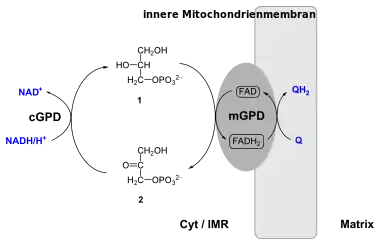Glycerol phosphate shuttle
The glycerol-3-phosphate shuttle is a mechanism that regenerates NAD+ from NADH, a by-product of glycolysis. The shuttle consists of the sequential activity of two proteins: GPD1 which transfers an electron pair from NADH to dihydroxyacetone phosphate (DHAP), forming glycerol-3-phosphate (G3P) and regenerating NAD+ needed to generate energy via glycolysis.[1] The mitochondrial inner membrane protein GPD2 catalyzes the oxidation of G3P, regenerating DHAP in the cytosol and forming FADH2 in the mitochondrial matrix.[2] In mammals, its activity in transporting reducing equivalents across the mitochondrial membrane is considered secondary to the malate-aspartate shuttle.

History
The glycerol phosphate shuttle was first characterized as a major route of mitochondrial hydride transport in the flight muscles of blow flies.[3][4] It was initially believed that the system would be inactive in mammals due to the predominance of lactate dehydrogenase activity over Glycerol-3-phosphate dehydrogenase 1 (GPD1)[3][5] until high GPD1 and GPD2 activity were demonstrated in mammalian brown adipose tissue and pancreatic ß-islets.[6][7][8][9]
Reaction
In this shuttle, the enzyme called cytoplasmic glycerol-3-phosphate dehydrogenase 1 (GPD1 or cGPD) converts dihydroxyacetone phosphate (2) to glycerol 3-phosphate (1) by oxidizing one molecule of NADH to NAD+ as in the following reaction:

Glycerol-3-phosphate is converted back to dihydroxyacetone phosphate by an inner membrane-bound mitochondrial glycerol-3-phosphate dehydrogenase 2 (GPD2 or mGPD), this time reducing one molecule of enzyme-bound flavin adenine dinucleotide (FAD) to FADH2. FADH2 then reduces coenzyme Q (ubiquinone to ubiquinol) whose electrons enter into oxidative phosphorylation.[10] This reaction is irreversible.[11]
References
- "GPD1 glycerol-3-phosphate dehydrogenase 1 [Homo sapiens (human)] - Gene - NCBI". www.ncbi.nlm.nih.gov. Retrieved 2021-05-03.
- "GPD2 glycerol-3-phosphate dehydrogenase 2 [Homo sapiens (human)] - Gene - NCBI". www.ncbi.nlm.nih.gov. Retrieved 2021-05-03.
- Estabrook RW, Sacktor B (October 1958). "alpha-Glycerophosphate oxidase of flight muscle mitochondria". The Journal of Biological Chemistry. 233 (4): 1014–9. PMID 13587533.
- Sacktor B, Dick A (October 1962). "Pathways of hydrogen transport in the oxidation of extramitochondrial reduced diphosphopyridine nucleotide in flight muscle". The Journal of Biological Chemistry. 237 (10): 3259–63. PMID 13975951.
- Boxer GE, Shonk CE (January 1960). "Low levels of soluble DPN-linked alpha glycerophosphate dehydrogenase in tumors". Cancer Research. 20: 85–91. PMID 13803504.
- Ohkawa KI, Vogt MT, Farber E (May 1969). "Unusually high mitochondrial alpha glycerophosphate dehydrogenase activity in rat brown adipose tissue". The Journal of Cell Biology. 41 (2): 441–9. doi:10.1083/jcb.41.2.441. PMC 2107766. PMID 5783866.
- Houstek J, Cannon B, Lindberg O (1975). "Glycerol-3-phosphate shuttle and its function in intermediate metabolism of hamster brown-adipose tissue". European Journal of Biochemistry. 54: 11–18.
- Ratner PL, Fisher M, Burkart D, Cook JR, Kozak LP (April 1981). "The role of mRNA levels and cellular localization in controlling sn-glycerol-3-phosphate dehydrogenase expression in tissues of the mouse". The Journal of Biological Chemistry. 256 (7): 3576–9. PMID 6782104.
- Koza RA, Kozak UC, Brown LJ, Leiter EH, MacDonald MJ, Kozak LP (December 1996). "Sequence and tissue-dependent RNA expression of mouse FAD-linked glycerol-3-phosphate dehydrogenase". Archives of Biochemistry and Biophysics. 336 (1): 97–104. doi:10.1006/abbi.1996.0536K. PMID 8951039.
- Stryer, Lubert; Berg, Jeremy Mark; Tymoczko, John L. (2007). Biochemistry. San Francisco: W. H. Freeman. ISBN 978-0-7167-8724-2. Archived from the original on 2007-05-18.
- Shen W, Wei Y, Dauk M, et al. (February 2006). "Involvement of a glycerol-3-phosphate dehydrogenase in modulating the NADH/NAD+ ratio provides evidence of a mitochondrial glycerol-3-phosphate shuttle in Arabidopsis". Plant Cell. 18 (2): 422–41. doi:10.1105/tpc.105.039750. PMC 1356549. PMID 16415206.
External links
- http://chemistry.elmhurst.edu/vchembook/601glycolysissum.html (describes the shuttle in the context of glycolysis)